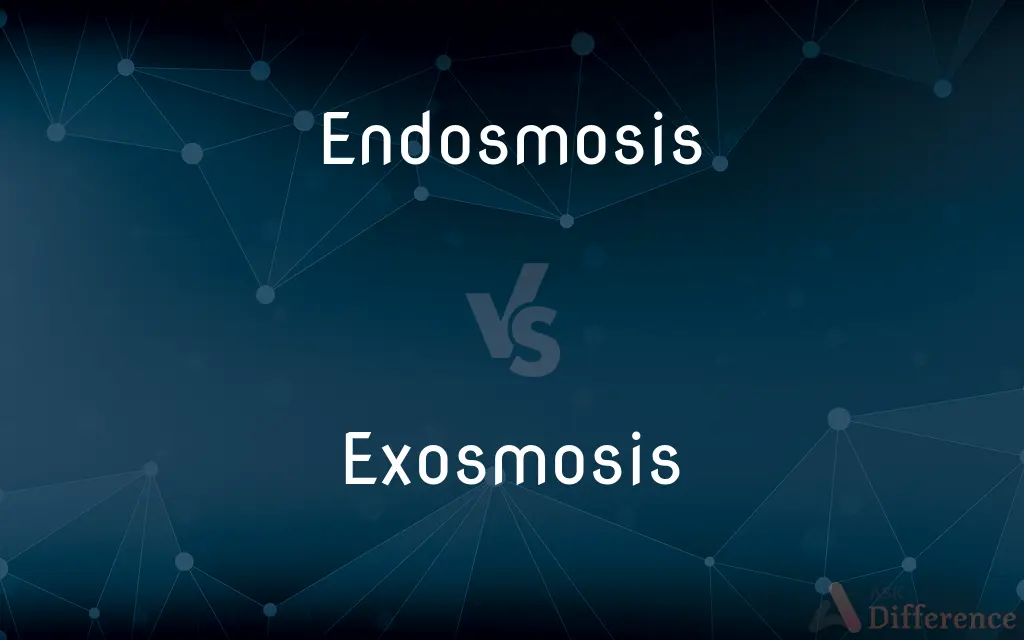Endosmosis vs. Exosmosis — What's the Difference?
Edited by Tayyaba Rehman — By Fiza Rafique — Updated on May 8, 2024
Endosmosis involves the inward movement of solvent molecules through a semipermeable membrane toward higher solute concentration, while exosmosis is the outward movement from higher to lower solute concentration.

Difference Between Endosmosis and Exosmosis
Table of Contents
ADVERTISEMENT
Key Differences
Endosmosis occurs when solvent molecules move from a region of lower solute concentration to a region of higher concentration across a semipermeable membrane, emphasizing solute concentration gradients as a driving force. On the other hand, exosmosis happens as solvent molecules move in the opposite direction, from areas of higher to lower solute concentration, effectively reducing solute disparities.
The process of endosmosis can cause cells in a hypotonic solution to swell as water enters the cell. Conversely, exosmosis leads to cell shrinking or plasmolysis when they are in a hypertonic solution, as water exits the cell.
Endosmosis is crucial in maintaining cellular turgidity, essential for plant cells to remain stiff and upright. In contrast, exosmosis can result in cell shrinkage and wilting in plants if excessive.
Osmotic pressure is directly involved in endosmosis, driving water into areas where it can balance solute concentrations. Meanwhile, exosmosis is influenced by the same osmotic pressure but facilitates the exit of water, attempting to equalize the concentration across the membrane.
Practical applications of endosmosis include medical therapies like rehydration treatments where fluids are administered to increase bodily fluids internally. Exosmosis finds its application in food preservation techniques that involve dehydrating food to prevent microbial growth.
ADVERTISEMENT
Comparison Chart
Direction of Movement
Inward towards higher solute concentration
Outward towards lower solute concentration
Effect on Cells
Causes cells to swell (turgid)
Causes cells to shrink (plasmolyzed)
Solution Type Involved
Hypotonic solution (outside the cell)
Hypertonic solution (outside the cell)
Role of Osmotic Pressure
Increases as solvent moves in
Decreases as solvent moves out
Practical Applications
Rehydration therapies, maintaining plant turgidity
Food preservation, controlling microbial growth
Compare with Definitions
Endosmosis
A process contributing to the turgidity of plant cells.
Endosmosis is essential for keeping celery stalks crisp.
Exosmosis
A process that can lead to the wilting of plant structures.
Excessive exosmosis in plants leads to wilting and droopiness.
Endosmosis
Movement of a solvent into an area of higher solute concentration in response to osmotic pressure.
Endosmosis can be observed when a raisin is placed in fresh water.
Exosmosis
Movement of a solvent out of an area of higher solute concentration.
Exosmosis occurs when salt is sprinkled on cucumbers.
Endosmosis
The diffusion of water into a cell or vessel through a selectively permeable membrane.
Endosmosis helps plant roots absorb water from the soil.
Exosmosis
The diffusion of water out of a cell or vessel through a selectively permeable membrane.
Exosmosis can cause dehydration in plant tissues.
Endosmosis
A vital process in biological hydration mechanisms.
Endosmosis is used in medical treatments to rehydrate patients.
Exosmosis
Critical in food preservation methods to inhibit microbial growth.
Exosmosis is employed in the dehydration of fruits for preservation.
Endosmosis
A phenomenon observed in various biological and chemical experiments.
Endosmosis is often demonstrated in laboratory settings using dialysis tubing.
Exosmosis
A fundamental concept in studies of osmotic pressure and balance.
Exosmosis is studied in biology to understand fluid balances in cells.
Endosmosis
The inward flow of a fluid through a permeable membrane toward a fluid of greater concentration.
Exosmosis
The passage of a fluid through a semipermeable membrane toward a solution of lower concentration, especially the passage of water through a cell membrane into the surrounding medium.
Endosmosis
Osmosis in which fluid flows through a membrane towards a region of higher concentration
Exosmosis
Osmosis in which fluid flows through a membrane towards a region of lower concentration
Exosmosis
See Exosmose.
Common Curiosities
Can endosmosis occur without a semipermeable membrane?
No, endosmosis requires a semipermeable membrane to allow selective movement of water towards higher solute concentrations.
What triggers exosmosis in cells?
Exosmosis is triggered when cells are in environments with higher external solute concentrations, prompting water to move out to balance solute levels.
How does exosmosis affect food preservation?
Exosmosis helps remove moisture from food, reducing microbial growth and spoilage, thereby extending shelf life.
Can plants survive without endosmosis?
No, plants rely on endosmosis to absorb water through their roots and maintain turgidity, critical for their survival.
How do endosmosis and exosmosis contribute to cell function?
Endosmosis helps maintain cell volume and pressure, necessary for cellular activities, while exosmosis can regulate cell content and prevent bursting in hypertonic conditions.
What role does endosmosis play in human health?
Endosmosis is crucial in processes like nutrient absorption and cellular hydration, essential for overall health.
What factors affect the rate of endosmosis?
Factors include the concentration gradient, temperature, and the permeability of the membrane to the solvent.
What scientific principles underlie endosmosis and exosmosis?
Both processes are governed by principles of diffusion and osmosis, fundamental to understanding fluid and solute movements in biological systems.
Is osmotic pressure always involved in endosmosis and exosmosis?
Yes, osmotic pressure drives both endosmosis and exosmosis, influencing the direction and rate of water movement through membranes.
Does exosmosis always result in dehydration?
In biological contexts, exosmosis can lead to dehydration if it continues unchecked, as seen in plant wilting or in cells in a hypertonic solution.
What are some everyday examples of exosmosis?
Everyday examples include the salting of meat to preserve it and the drying out of a slug when exposed to salt.
What happens to animal cells during exosmosis?
In exosmosis, animal cells may shrink and become crenated if excessive water moves out, potentially disrupting cell function.
How do endosmosis and exosmosis affect plant health?
Endosmosis supports hydration and nutrient uptake, vital for growth; exosmosis can cause dehydration and nutrient loss, potentially harming the plant.
Can exosmosis be reversed?
Exosmosis can be reversed by changing the external environment to a more hypotonic one, where water will move back into the cells (endosmosis).
How are endosmosis and exosmosis demonstrated in laboratories?
These processes are typically demonstrated using dialysis tubing in different solute concentrations, visually showing water movement and effects on cell-like structures.
Share Your Discovery

Previous Comparison
Beneficence vs. Nonmaleficence
Next Comparison
Skull vs. CraniumAuthor Spotlight
Written by
Fiza RafiqueFiza Rafique is a skilled content writer at AskDifference.com, where she meticulously refines and enhances written pieces. Drawing from her vast editorial expertise, Fiza ensures clarity, accuracy, and precision in every article. Passionate about language, she continually seeks to elevate the quality of content for readers worldwide.
Edited by
Tayyaba RehmanTayyaba Rehman is a distinguished writer, currently serving as a primary contributor to askdifference.com. As a researcher in semantics and etymology, Tayyaba's passion for the complexity of languages and their distinctions has found a perfect home on the platform. Tayyaba delves into the intricacies of language, distinguishing between commonly confused words and phrases, thereby providing clarity for readers worldwide.
















































